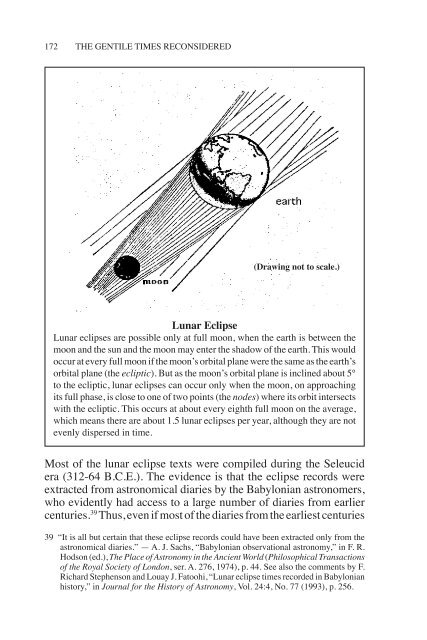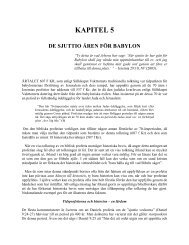4 the absolute chronology of the neo-babylonian era - Kristen Frihet
4 the absolute chronology of the neo-babylonian era - Kristen Frihet
4 the absolute chronology of the neo-babylonian era - Kristen Frihet
Create successful ePaper yourself
Turn your PDF publications into a flip-book with our unique Google optimized e-Paper software.
172 THE GENTILE TIMES RECONSIDERED<br />
(Drawing not to scale.)<br />
Lunar Eclipse<br />
Lunar eclipses are possible only at full moon, when <strong>the</strong> earth is between <strong>the</strong><br />
moon and <strong>the</strong> sun and <strong>the</strong> moon may enter <strong>the</strong> shadow <strong>of</strong> <strong>the</strong> earth. This would<br />
occur at every full moon if <strong>the</strong> moon’s orbital plane were <strong>the</strong> same as <strong>the</strong> earth’s<br />
orbital plane (<strong>the</strong> ecliptic). But as <strong>the</strong> moon’s orbital plane is inclined about 5°<br />
to <strong>the</strong> ecliptic, lunar eclipses can occur only when <strong>the</strong> moon, on approaching<br />
its full phase, is close to one <strong>of</strong> two points (<strong>the</strong> nodes) where its orbit intersects<br />
with <strong>the</strong> ecliptic. This occurs at about every eighth full moon on <strong>the</strong> av<strong>era</strong>ge,<br />
which means <strong>the</strong>re are about 1.5 lunar eclipses per year, although <strong>the</strong>y are not<br />
evenly dispersed in time.<br />
Most <strong>of</strong> <strong>the</strong> lunar eclipse texts were compiled during <strong>the</strong> Seleucid<br />
<strong>era</strong> (312-64 B.C.E.). The evidence is that <strong>the</strong> eclipse records were<br />
extracted from astronomical diaries by <strong>the</strong> Babylonian astronomers,<br />
who evidently had access to a large number <strong>of</strong> diaries from earlier<br />
centuries. 39 Thus, even if most <strong>of</strong> <strong>the</strong> diaries from <strong>the</strong> earliest centuries<br />
39 “It is all but certain that <strong>the</strong>se eclipse records could have been extracted only from <strong>the</strong><br />
astronomical diaries.” — A. J. Sachs, “Babylonian observational astronomy,” in F. R.<br />
Hodson (ed.), The Place <strong>of</strong> Astronomy in <strong>the</strong> Ancient World (Philosophical Transactions<br />
<strong>of</strong> <strong>the</strong> Royal Society <strong>of</strong> London, ser. A. 276, 1974), p. 44. See also <strong>the</strong> comments by F.<br />
Richard Stephenson and Louay J. Fatoohi, “Lunar eclipse times recorded in Babylonian<br />
history,” in Journal for <strong>the</strong> History <strong>of</strong> Astronomy, Vol. 24:4, No. 77 (1993), p. 256.




